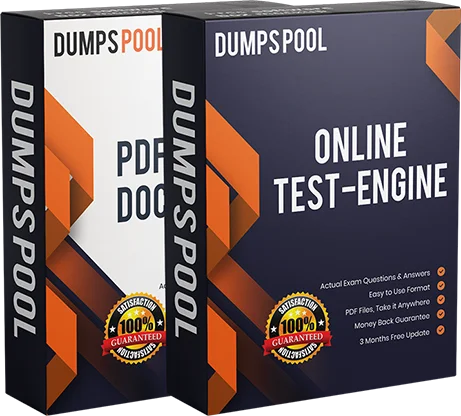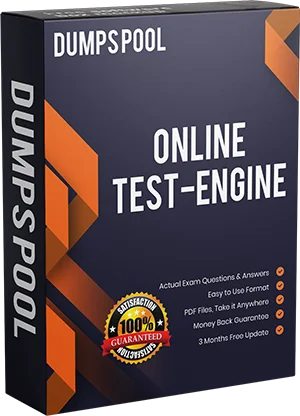PDF Only

$40.00 Free Updates Upto 90 Days
- UiPath-SAIv1 Dumps PDF
- 79 Questions
- Updated On July 26, 2024
PDF + Test Engine

$60.00 Free Updates Upto 90 Days
- UiPath-SAIv1 Question Answers
- 79 Questions
- Updated On July 26, 2024
Test Engine

$50.00 Free Updates Upto 90 Days
- UiPath-SAIv1 Practice Questions
- 79 Questions
- Updated On July 26, 2024
How to pass UiPath UiPath-SAIv1 exam with the help of dumps?
DumpsPool provides you the finest quality resources you’ve been looking for to no avail. So, it's due time you stop stressing and get ready for the exam. Our Online Test Engine provides you with the guidance you need to pass the certification exam. We guarantee top-grade results because we know we’ve covered each topic in a precise and understandable manner. Our expert team prepared the latest UiPath UiPath-SAIv1 Dumps to satisfy your need for training. Plus, they are in two different formats: Dumps PDF and Online Test Engine.
How Do I Know UiPath UiPath-SAIv1 Dumps are Worth it?
Did we mention our latest UiPath-SAIv1 Dumps PDF is also available as Online Test Engine? And that’s just the point where things start to take root. Of all the amazing features you are offered here at DumpsPool, the money-back guarantee has to be the best one. Now that you know you don’t have to worry about the payments. Let us explore all other reasons you would want to buy from us. Other than affordable Real Exam Dumps, you are offered three-month free updates.
You can easily scroll through our large catalog of certification exams. And, pick any exam to start your training. That’s right, DumpsPool isn’t limited to just UiPath Exams. We trust our customers need the support of an authentic and reliable resource. So, we made sure there is never any outdated content in our study resources. Our expert team makes sure everything is up to the mark by keeping an eye on every single update. Our main concern and focus are that you understand the real exam format. So, you can pass the exam in an easier way!
IT Students Are Using our UiPath Certified Professional Specialized AI Professional v1.0 Dumps Worldwide!
It is a well-established fact that certification exams can’t be conquered without some help from experts. The point of using UiPath Certified Professional Specialized AI Professional v1.0 Practice Question Answers is exactly that. You are constantly surrounded by IT experts who’ve been through you are about to and know better. The 24/7 customer service of DumpsPool ensures you are in touch with these experts whenever needed. Our 100% success rate and validity around the world, make us the most trusted resource candidates use. The updated Dumps PDF helps you pass the exam on the first attempt. And, with the money-back guarantee, you feel safe buying from us. You can claim your return on not passing the exam.
How to Get UiPath-SAIv1 Real Exam Dumps?
Getting access to the real exam dumps is as easy as pressing a button, literally! There are various resources available online, but the majority of them sell scams or copied content. So, if you are going to attempt the UiPath-SAIv1 exam, you need to be sure you are buying the right kind of Dumps. All the Dumps PDF available on DumpsPool are as unique and the latest as they can be. Plus, our Practice Question Answers are tested and approved by professionals. Making it the top authentic resource available on the internet. Our expert has made sure the Online Test Engine is free from outdated & fake content, repeated questions, and false plus indefinite information, etc. We make every penny count, and you leave our platform fully satisfied!
Frequently Asked Questions
Question # 1
What is the Machine Learning Extractor?
A. A specialized model that can recognize multiple languages in the same document usingAPI calls to a Hugging Face model with over 250 languages.
B. An extraction model that can be enabled and trained in Al Center. For better accuracy.25 documents per model are recommended to train the model.
C. A tool using machine learning models to identify and report on data targeted for dataextraction.
D. A tool that helps extract data from different document structures, and is particularlyuseful when the same document has multiple formats.
Question # 2
Which of the following are unstructured documents?
A. Invoices, receipts, purchase orders, and medical bills.
B. Banking forms, tax forms, surveys, and identity cards.
C. Contracts, emails, banking forms, and tax forms.
D. Contracts, agreements, and emails.
Question # 3
Which environment variable is relevant for Evaluation pipelines?
A. eval.enable_ocr
B. eval.redo_ocr
C. eval.enable_qpu
D. eval.use_cuda
Question # 4
What is the name of the web application that allows users to prepare, review, and makecorrections to datasets required for Machine Learning models?
A. Document Manager.
B. Digitization.
C. Data Manager.
D. ML Extractor.
Question # 5
How can the code be tested in a development or testing environment in the context of theDocument Understanding Process?
A. Use them as a template to create other tests.
B. Simply run the existing tests
C. Based on the use case developed, create test data to test existing and new tests.
D. Based on the use case developed, create test data to test existing tests.
Question # 6
What is one of the purposes of the Config file in the UiPath Document UnderstandingTemplate?
A. It contains the configuration settings for the UiPath Robot and Orchestrator integration.
B. It stores the API keys and authentication credentials for accessing external services.
C. It specifies the output file path and format for the processed documents.
D. It defines the input document types and formats supported by the template.
Question # 7
Which of the following OCR (Optical Character Recognition) engines is not free of charge?
A. Tesseract.
B. Microsoft Azure OCR.
C. OmniPaqe.
D. Microsoft OCR.
Question # 8
What do entity predictions refer to within UiPath Communications Mining?
A. The understanding of the parent-label relationship when assigning label predictions.
B. The difference between label suggestions and label predictions in a training process.
C. The identification of a specific span of text as a value for a particular entity type.
D. The model's confidence that a specific concept exists within a communication.
Question # 9
What can be done in the Reports section of the dataset navigation bar in UiPathCommunication Mining?
A. Train models using unsupervised learning.
B. View, save, and modify dataset model versions.
C. Monitor model performance and receive recommendations.
D. Access detailed, quervable charts, statistics, and customizable dashboards.
Question # 10
Why might labels have bias warnings in UiPath Communications Mining, even with 100%precision?
A. They were trained using the "Search" option extensively.
B. They were trained using the "Shuffle" option extensively.
C. They have low recall.
D. They lack training examples.
Question # 11
Which technology enables UiPath Communications Mining to analyze and enable action onmessages?
A. Natural Language Processing (NLP)
B. Virtual Reality.
C. Cloud Computing.
D. Robotic Process Automation
Question # 12
Which of the following consumes Page Units?
A. Applying OCR on a 10-page document.
B. Creation of a Document Validation Action in Action Center.
C. Using ML Classifier on a 21-page document.
D. Using Intelligent Form Extractor on a 5-page document with 0 successful extractions.
Question # 13
What does the Label Trends table in UiPath Communications Mining show?
A. How the top 10 labels for a given time period perform compared to the previous periodand their change in rank.
B. How the top 10 senders for a given time period perform compared to the previous periodand their change in rank.
C. How the top 10 entities for a given time period perform compared to the previous periodand their change in rank.
D. How the top 10 labels and entities for a given time period perform compared to theprevious period and their change in rank.
Question # 14
When creating a training dataset, what is the recommended number of samples for theClassification fields?
A. 5-10 document samples from each class.
B. 10-20 document samples from each class.
C. 20-50 document samples from each class.
D. 50-200 document samples from each class.
Question # 15
What are the languages supported by the generic Document Understanding ML Package?
A. Languages using the Greek left-to-right alphabet. Japanese, and Chinese.
B. Languages using the Cyrillic alphabet, the Greek left-to-right alphabet, and Chinese.
C. Languages using the Latin alphabet (like Italian, French. Portuguese. Spanish, andRomanian), and the Greek left-to-right alphabet.
D. Languages using the Latin alphabet, the Cyrillic alphabet, the Greek left-to-rightalphabet. Japanese, and Chinese.
Question # 16
In which of the following scenarios, the ML Classifier is the only recommended classifier tobe used, according to best practice?
A. When the custom document types are very similar and file splitting is not necessary.
B. When the custom document types are not similar and file splitting is not necessary.
C. When the custom document types are not similar and file splitting is necessary.
D. When the custom document types are very similar and file splitting is necessary.
Leave a comment
Your email address will not be published. Required fields are marked *